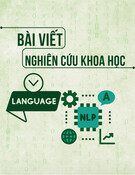
USING ENGLISH COLLOCATIONS TO IMPROVE WRITING
SKILLS FOR FIRST-YEAR ENGLISH MAJORED STUDENTS AT
DONG NAI TECHNOLOGY UNIVERSITY
Le Tien Tung1*, Tran Thi Thuy Loan2
1Binh Duong Economics and Technology University
2Dong Nai Technology University
*Corresponding author: Le Tien Tung, Tung.lt@ktkt.edu.vn
1. INTRODUCTION
English is the world language and is the
dominant foreign language in the national
education system in Vietnam. Undergraduate
students are required to attain a certain level of
English proficiency whether they are English-
majored or non-English-majored
undergraduates to be eligible for graduation
(MOET, 2008). Therefore, universities in
Vietnam design various English programs to
advance their students’ English proficiency to
meet the requirements of the Vietnam
government and the demands of the labor
markets (Le, T. T., Hoang, D. T. N., 2023).
Similar to other universities in Vietnam, Dong
Nai Technology University (DNTU) designs
several English programs for English-majored
students, of which, teaching English writing is
one of the mandatory components of the
English program to improve undergraduates’
communication skills. Writing proficiency is
the ability to convey thoughts, ideas, and
information in a coherent and articulated
manner through writing. Therefore, teaching
writing is essential for university students who
are required to complete a high workload of
assignments and other writing tasks to become
proficient in writing English. Writing tasks
often require a high level of correctness and are
regarded as one of the most difficult subjects in
teaching English to non-native English students
(Phuong, W. T. N., 2021).
Teaching writing is a dynamic,
multidimensional process that entails assisting
people in navigating the challenging process of
GENERAL INFORMATION
ABSTRACT
Received date: 12/08/2024
This study investigates the impact of using collocations in teaching
writing English as a Foreign Language (EFL) for first-year English
majored students at Dong Nai Technology University (DNTU), and
the attitudes of these students towards the application of collocations
in the writing course. The quantitative approach was employed in this
study. A 3-
week training course using collocations in descriptive
paragraph writing for 38 English majored first-year students at DNTU
was organized. Pre-test and post-
test questionnaire surveys were
conducted to explore the students' perspectives toward the application
of collocations in the writing course. The results showed that using
collocations in the English writing lessons helped improve writing
skills for the English majored first-year students at DNTU, and the
first-year students who participated in the study had positive attitudes
towards the application of collocations in the English writing course.
Revised date: 12/09/2024
Accepted date: 30/09/2024
TỪ KHÓA
Collocations;
English first-year ;
English writing .
150

putting ideas, feelings, and thoughts into
comprehensible, persuasive written form. It
includes teaching students the fundamentals of
grammar, syntax, organization, and critical
thinking to enable them to communicate clearly
and precisely. Effective teaching writing not
only transmits technical competency but also
fosters creativity and creates an environment in
which individuals can use written expression to
explore their voices and viewpoints. It is a
transforming experience that gives students a
tool for expression that they can use for the rest
of their lives, helping them to negotiate the
challenges of interpersonal, professional, and
academic communication (Nizonkiza, D.,
2017). To facilitate the English-majored first-
year students in improving their English writing
competencies, a ten-week English writing
course was designed as a part of the English
program and offered to them at the beginning
of the first year at DNTU. The course adopts a
carefully structured curriculum that covers
fundamental writing principles, including
grammar, syntax, and essay organization.
However, the short duration courses places
great pressure on students to complete the
course within a compressed timeframe and
makes them compromise the quality and logical
coherence of the written pieces. To help the
English-majored first-year students acquire the
required English writing proficiency within a
constrained timeframe, a new innovative
teaching English writing approach was applied
which uses collocations in descriptive
paragraph writing.
Collocation is the way words combine in a
language to produce natural-sounding speech
and writing. Collocation is a pair or a group of
words that are often used together. Collocations
are combinations of two or more words that
frequently occur together in a language. As
noted by Hill (2000), collocations are not just
random word combinations but are predictable
and often fixed patterns that native speakers use
naturally. Benson, Benson, and Ilson (1986)
further categorize collocations into two main
types: lexical collocations and grammatical
collocations. Lexical collocations include
combinations like verb + noun (e.g., "make a
decision") or adjective + noun (e.g., "strong
tea"), while grammatical collocations involve a
content word + grammatical structure (e.g.,
"depend on," "interested in").
The important role of collocation in writing
ability is exploring how thoughtful word choice
can improve the clarity and quality of written
communication. Collocations are important for
English as a Second Language (ESL) and
English as a Foreign Language (EFL) learning
because they enhance student's writing style
and facilitate them to convey their thoughts
more naturally by using frequent word pairings
(O’Dell, F., & McCathy, M., 2011). Similarly,
Kim, H., & Bae, J. (2012) argued that using the
appropriate collocations enhances student's
writing. Therefore, acquiring an understanding
of collocations’ function in language
competence is essential for teachers and
students looking to improve their writing.
Students may convey their thoughts more
naturally by using frequent word pairings as the
other word selection options that are more
vivid, expressive, and accurate combinations.
Students who master collocation will have the
ability to select words that are appropriate for
the situation. This ability is especially crucial
for writing in academic and professional
contexts, where relevancy and accuracy are
crucial. Students can prevent typical language
problems like word abuse and odd wording by
being aware of collocation. This skill enhances
the correctness and intelligibility of students’
written work.
Mastering collocations not only helps
improve students’ writing skills but also
expands their lexical range by encouraging the
use of diverse and contextually appropriate
word combinations (Bahardoust, M., & Moeini,
151

M. R., 2012). This not only enriches the
language but also demonstrates a higher level
of vocabulary mastery. Writing proficiency in
collocation is best developed through
continuous practice and exposure. Regular
writing tasks, reading authentic texts, and
engaging in language-rich activities contribute
to the gradual internalization of collocational
patterns.
A paragraph is a group of sentences that
develops one main idea or a topic (Smalley &
Ruetten, 1986). A paragraph consists of a main
sentence, supporting sentences, and a
conclusion phrase (Savage & Shafiei., 2012).
The topic sentence appears first and presents
the main concept. The topic's material is further
explained in the following phrases, and the
conclusion comes last. Effective paragraph
organization is a fundamental aspect of clear
and cohesive writing. It begins with a strong
topic sentence that introduces the main idea,
guiding the reader on what to expect.
Supporting details or examples follow,
logically arranged to provide depth and context.
Transition words ensure smooth connections
between sentences, maintaining a fluid flow of
ideas. Unity and coherence are crucial; every
sentence should contribute to the central theme
established in the topic sentence. A concluding
sentence summarizes key points, offering
closure. Varied sentence structures, consistent
verb tense, and the elimination of redundancy
enhance the paragraph's readability. Revision
and proofreading ensure clarity, coherence, and
correct usage. By adhering to these principles,
writers can create well-organized paragraphs
that effectively convey their intended message.
There are several types of paragraphs, and
the descriptive paragraph is like a painting with
words that help the reader visualize a certain
person, place, or object (Savage & Shafiei,
2012). A descriptive paragraph is like a
snapshot captured with words, painting a vivid
picture in the reader's mind and providing
sensory details to create a rich and immersive
experience (Smalley & Ruetten., 1986). It often
begins with a topic sentence that introduces the
main subject, setting the stage for the following
detailed description. A combination of
expressive language, adjectives, adverbs, and
figurative devices are used to appeal to the
reader's senses – sight, sound, touch, taste, and
smell. The arrangement of details follows a
logical sequence, allowing the reader to
visualize and feel the described scene or object
progressively. Descriptive paragraphs aim to
evoke emotions, engage the reader's
imagination, and convey a strong sense of
presence. Whether depicting a serene natural
landscape, a bustling city street, or a cherished
childhood memory, the artful use of descriptive
language brings the narrative to life, making it
more vibrant and memorable.
A descriptive paragraph is a way of writing
that helps the reader imagine things clearly.
Instead of just saying something, it uses
colorful language to make you feel like you are
right there. To write a good descriptive
paragraph, students need to pay attention to
details using their senses - what they can see,
hear, touch, taste, and smell when they describe
things. For example, to describe a beautiful
beach, students would start by talking about the
bright sun, the sound of waves, and the warm
sand under the feet. Students might use words
that make the reader feel the cool breeze or taste
the salty air. It is like creating a movie in the
reader's mind.
2. METHODOLOGY
2.1 Research design
The purpose of this study is to investigate
the impact of using collocations in teaching
writing English as a Foreign Language (EFL)
for English-majored first-year students at Dong
Nai Technology University (DNTU) and
explore their attitudes toward the application of
collocations in the writing course. The
152

quantitative approach was employed to
examine the impacts of using collocations on
the English writing skills of the English-
majored first-year students through a ten-week
experiment English writing course using a
descriptive paragraph writing style. The course
book selected for the writing course named
"Writing 1" which was carefully prepared by
the lecturers of the Faculty of Foreign
Languages at DNTU in 2021. The writing
course included thirty ninety-minute sessions
with a focus on the following topics:
1. Collocations for characterizing persons
were introduced and practiced in writing
sentences before the appropriate paragraph was
written during the first lesson.
2. Collocations for depicting landscapes
were presented and practiced in writing
sentences and pertinent paragraphs in the
second session.
3. Collocations for describing food were
introduced and exercised in writing sentences
and pertinent paragraphs during the third
lesson.
In addition, the pre-test and post-test
surveys were conducted before and after the
course to examine the understanding of the
students about the use of collocations in writing
and to explore their perceptions toward the
collocations.
2.2 Participants
Convenient sampling was employed to
select thirty-eight English-majored first-year
students at DNTU, who voluntarily participated
in the study. The selected students have a
similar level of English proficiency based on
the English placement test results.
2.3 Research instruments
The questionnaire survey comprises twelve
questions with an emphasis on the knowledge,
attitudes, and judgments of the students. The
questionnaire surveys were conducted before
and after the experiment writing course. The
first five questions in Part A were designed to
assess the students' foundational understanding
of collocations. The remaining seven questions
in Part B assessed the students’ attitudes toward
using collocations in the English writing
course.
3. FINDINGS AND DISCUSSIONS
3.1. Results of Part A
The first five questions in Part A were
designed to assess the students' foundational
understanding of collocations. There were 100
points awarded overall. Every question
received a score of 20. There were five different
scales created from the results for each
question: below weak (0 - <7), weak (7 - <10),
average (10 - <13), fair (13 - <16), and good (16
- 20).
Chart 1: Question 1 - Adjective and noun
collocations.
The first question aimed to explore the
students’ understanding of adjective and noun
collocations. The pre-course survey results as
seen in Chart 1 indicated that only 4% of
students answered “average” as the highest
level. However, the post-course survey results
showed that 55% of students answered
"average", 17% as "fair," and 11% as "good”
respectively.
The results of the pre-and post-course
survey showed improvement in students’
awareness and understanding of collocations.
This suggests that teaching collocations to
describe people's appearances was successful.
153

Chart 2: Question 2 - Common expressions of
people’s characters.
If Question 1 focused on exploring
students’ general understanding of the
collocations which are formed by adjectives
and nouns, the subsequent questions were
designed to measure students’ understanding of
how collocations were used to describe
common things in daily life. The goal of
Question 2 was to evaluate students’
understanding of the meaning of several
collocations used to characterize persons. As
shown in Chart 2, the pre-course survey showed
that 88% of the students answered as "below
weak," and 12% answered as "average",
compared with only 17% of the students
answered as "weak", 50% as "average", 28% as
"fair", and 5% as "good".
The results of the pre-and post-course
survey indicated a significant improvement in
understanding the meaning of collocations that
were used to describe persons’ characteristics.
Chart 3: Question 3 - Common collocations
of describing landscapes.
Similar to Question 2, the third question
was designed to assess students' understanding
of collocations which were used to describe
landscapes. It was evident that the students had
a significant struggle to complete the survey
before the experiment course as there was not
any student who was able to choose the right
responses as shown in Chart 3. However, 28%
of students were rated as "weak," 44% as
"average," and 28% as "fair" in the post-course
survey. The survey results indicated that the
students gained more understanding and are
able to use collocations to depict landscapes
after attending the experiment English writing
course.
Chart 4: Question 4 - common collocations of
describing food.
Question 4 aimed to assess the student's
comprehension of the food-related expressions
using common collations. The survey results, as
shown in Chart 4, indicated that the "below
weak" answer decreased from 84% in the pre-
course to 0% in the post-course, whereas the
“fair” and “good” answers increased from 0%
to 34% and 5% respectively.
Chart 5: Question 5 - students’ self-evaluation
of using collocations in writing.
Question 5 was designed to examine
students’ self-evaluation of using collocations
in their writing work. The result, as shown in
Chart 5, indicated that most students in the pre-
course survey believed that collocations do not
help improve English writing. However, most
of them rated the use of collocations as “good”
in improving writing in the post-course survey.
154

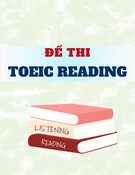

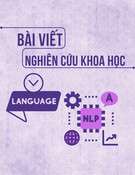







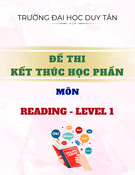
![Đề cương môn Tiếng Anh 1 [Chuẩn Nhất/Mới Nhất]](https://cdn.tailieu.vn/images/document/thumbnail/2025/20251130/cubabep141@gmail.com/135x160/51711764555685.jpg)


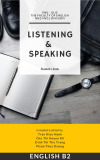



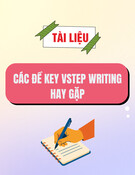
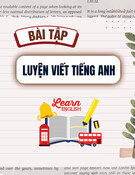
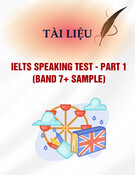

![Mẫu thư Tiếng Anh: Tài liệu [Mô tả chi tiết hơn về loại tài liệu hoặc mục đích sử dụng]](https://cdn.tailieu.vn/images/document/thumbnail/2025/20250814/vinhsannguyenphuc@gmail.com/135x160/71321755225259.jpg)
